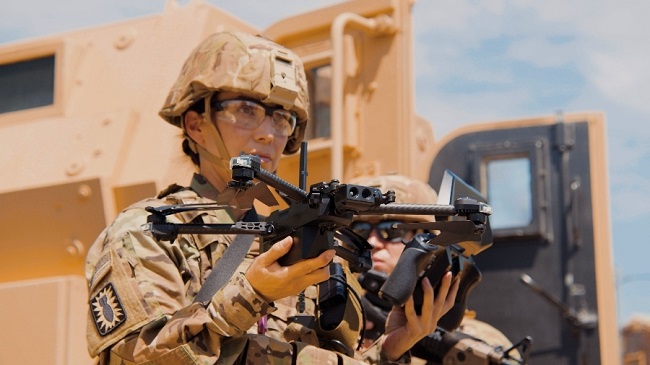
On 6 June, President Trump signed an Executive Order that is meant to accelerate the US investment in drones for both civilian and military purposes.
Noting that drones are “already transforming industries from logistics and infrastructure inspection to precision agriculture, emergency response, and public safety” and that emerging electric Vertical Take-Off and Landing (eVTOL) promise further revolutions in cargo delivery and passenger transport alike, the Order urges accelerated testing and the full integration of UAV into the National Airspace System.
The Secretary of Transportation, acting through the Administrator of the Federal Aviation Administration (FAA), is ordered to formulate, within 30 days, a proposal for rules enabling routine Beyond Visual Line of Sight (BVLOS) operations for UAV for commercial and public safety purposes. The rules are requested to be matured within 240 days.
Within 120 days, the FAA shall also “initiate the deployment of artificial intelligence (AI) tools” to assist in and expedite the review of UAV waiver applications. AI tools will be used in support of performance- and risk-based evaluations; for rapidly identifying materially similar precedents to cut down on duplications and accelerate standardized solutions; and to identify categories of operations with sufficient safety data or recurring approval patterns that may warrant further rulemaking to eliminate the need for individualized waivers.
Within 240 days the FAA is requested to produce a roadmap for the integration of civil UAV into the National Airspace System. Access to ranges to support the development, testing, and scaling of American drone technologies, with a focus on BVLOS operations, increasingly autonomous operations, advanced air mobility, and other advanced operations is to be expedited.
An eVTOL Integration Pilot Program (eIPP) is to be established and within 180 days “at least 5 pilot projects” that use US-developed or mainly US-sourced eVTOL technology and that are ready to begin operations within 90 days of the date of an agreement should be identified.
All agencies are instructed to “prioritize the integration of UAV manufactured in the United States over those made abroad to the maximum extent permitted by law”. In order to protect the US supply chain, a Covered Foreign Entity List is to be compiled within 30 days to identify companies that “pose supply chain risks”.
Within 90 days, authorities must look at measures and rules that “secure the US supply chain from foreign control or exploitation”.
The export of US drones is to be supported and accelerated, cutting down red tape and regulations where necessary, “to enable the expedited export of United States-manufactured civil UAV to foreign partners, provided such end-users and recipient countries are not identified as foreign adversaries and the export does not pose a risk of diversion to programs of concern”.
Export of US-manufactured civil UAV is to be designated as a priority area within the Department of Commerce’s export promotion efforts. The Export-Import Bank of the United States, the Chief Executive Officer of the United States International Development Finance Corporation, and the Director of the Trade and Development Agency shall all be instructed to favor export of drones through direct loans, credit facilitations, market access measures, technical assistance and other incentives.
When it comes to drones for military use, it is instructed that all platforms accepted on the Defense Innovation Unit’s (DIU) Blue UAS List should, “as soon as possible and to the fullest extent practicable”, be able to operate on all military installations or ranges without requiring exceptions to policy.
Within 90 days, the Blue UAS List shall be expanded to include “all drones and critical drone components compliant with section 848 of the National Defense Authorization Act for Fiscal Year 2020 (“FY 2020 NDAA”) (Public Law 116-92) to the fullest extent practicable”. From now on it is requested to update the Blue List once a month.
The Blue list began as an offshoot of the US Army’s Short Range Reconnaissance (SRR). During the prototype phase for that specific project, the Fiscal Year 2020 National Defense Authorization Act (NDAA) was signed into law and section 848 prohibited the use of certain components from covered countries.
The Defense Innovation Unit (DIU) initiated the “Blue sUAS” effort in August 2020, which sought a unified DoD approval for the then 5 candidate SRR solutions. That process was subsequently repeated to expand the list of cleared, certified systems.
To be given the Blue UAS designation, drones must meet specific and rigorous standards related to security and trusted technology. These standards ensure that the drones don’t pose risks associated with potential data breaches or unwanted data transmission to foreign entities.
Drones already compliant with the section 848 should be procured expeditiously, but the Executive Orders instruct that non compliance should not be a barrier to the adoption of systems that promise advancements over adversary capabilities.
Importantly, within 90 days, the Secretary of Defense shall “task the Secretary of each military department to identify programs that would be more cost efficient or lethal if replaced by UAV”. One system that already appears to have been identified as best replaced by drone-based capabilities, according to what we know about the FY 2026 defense plans, is the TOW missile. All acquisitions of it are expected to cease.
(Picture: Skydio X2D Multiband drone)








.png)
